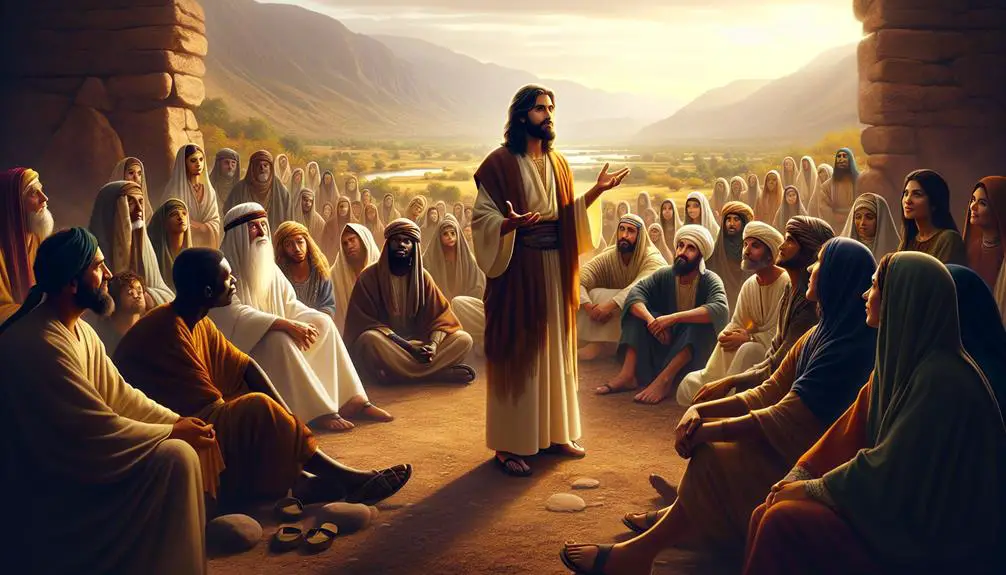Journey through the Bible as 'Behold' unveils pivotal moments, inviting deeper exploration into its transformative power.

Behold in the Bible
Imagine you're exploring the dense narrative of Genesis, where 'Behold' punctuates the moment of creation, inviting you to witness the unfolding of the world. This term, rich in anticipation and revelation, peppers the Bible, signaling moments of importance that demand your attention.
As you consider its use from the first flickers of light to the prophetic visions in Revelations, you'll uncover layers of meaning that might transform your understanding of biblical texts. Let's say you're intrigued by how a single word can weave through stories and teachings, guiding the reader to pause and observe.
How might this insight change your perspective on familiar passages?
Key Takeaways
- "Behold" commands attention, signaling moments of divine revelation and intervention in biblical narratives.
- It bridges humanity with creation, emphasizing cosmic imagery in creation stories and prophetic declarations.
- Through parables and teachings, "behold" underscores moral and spiritual lessons, engaging readers in moments of insight and observation.
- The term's evolution reflects societal and cultural shifts, shaping interpretations of biblical prophecies and stories.
The Origins of 'Behold

The term 'behold' originates from Old English, serving as a pivotal element in biblical texts to command attention and emphasize revelation. You'll observe its linguistic evolution as a testament to the dynamic nature of language and its ability to adapt to changing cultural contexts. This evolution isn't just a matter of linguistics but also a reflection of the societal shifts and the changing ways in which people have interpreted and interacted with religious texts over centuries.
In examining 'behold' within its cultural context, you'll find that its usage was far more than a mere stylistic choice. It was an integral part of the narrative structure in biblical times, designed to engage listeners and readers in a deeper, more profound understanding of the messages being conveyed. Its purpose was to make the audience stop, listen, and reflect—an effect that has diminished in modern translations of the Bible but remains a critical point of analysis for scholars and theologians alike.
The evolution of 'behold' exemplifies how words can gain and lose significance as cultures evolve. In its prime, 'behold' encapsulated a powerful method of storytelling and moral instruction, its imperative tone a call to perceive not just with the eyes but with the heart and mind. Analyzing its trajectory from a widely employed term in sacred texts to its near obsolescence today offers insights into the linguistic shifts that accompany and signify broader cultural transformations.
Understanding 'behold' in this comprehensive manner illuminates not just a linguistic curiosity but a window into the past, offering clues to how humans have historically navigated the complex interplay between language, culture, and spirituality.
Behold' in Creation Stories

Building on our understanding of 'behold's pivotal role in biblical language, let's explore its profound presence in creation stories, where it serves as a foundational element in shaping the narrative and theological implications. The use of 'behold' in these narratives isn't merely ornamental; it's a linguistic device that captures the awe and majesty of the divine act of creation, inviting readers into a moment of cosmic revelation.
- Cosmic Imagery: 'Behold' often precedes descriptions of the universe's formation, emphasizing the grandeur and majesty of the cosmos. This usage underlines the dramatic unveiling of creation, as if pulling back a curtain to reveal the masterpiece of divine craftsmanship.
- Linguistic Evolution: The term's application within creation narratives showcases its evolution from a simple attention-grabbing device to a complex term loaded with theological weight. It marks transitions, highlighting moments of significance within the act of creation.
- Narrative Pacing: Strategically placed 'behold' statements serve to pace the storytelling, creating pauses that allow the magnitude of what's being described to fully sink in. It's as if the narrative itself is in awe of the unfolding creation.
- Theological Implications: Each 'behold' invites readers to witness the unfolding mystery of creation, suggesting not just an observation but a participation in the divine act. It underscores the idea that creation isn't just an event in the past, but a revelation to be continuously engaged with.
Analyzing 'behold' in creation stories reveals its role as more than a mere word; it's a bridge connecting humanity with the awe-inspiring act of divine creation, enriched with cosmic imagery and linguistic evolution that deepen our understanding of the biblical narrative.
Prophetic Declarations and 'Behold

You'll find that the use of 'behold' in prophetic declarations isn't just a stylistic choice; it serves to amplify the prophetic impact and significance of the messages conveyed.
By examining how 'behold' is utilized, you gain insights into the depth of its purpose, often heralding a call for attention to divine revelations or impending changes.
This exploration allows for a more nuanced understanding of the narrative techniques biblical authors employed to engage and instruct their audiences.
Prophetic Impact Significance
In biblical texts, the use of 'behold' within prophetic declarations serves as a powerful tool, signaling moments of significant revelation and divine intervention. This term, deeply rooted in historical context, carries weight in prophetic literature, inviting you to ponder its cultural interpretations and the manifold ways it shapes understanding.
When examining 'behold' in prophecies, consider:
- The historical context in which these declarations were made.
- Cultural interpretations that influence the perception of these revelations.
- The role of 'behold' in signaling divine intervention.
- Its impact on the audience's anticipation and understanding of prophetic messages.
Understanding 'Behold' Usage
Delving into the usage of 'behold' within prophetic declarations reveals its pivotal role in shaping the listeners' understanding and anticipation of divine messages.
This term's presence underscores a moment of heightened attention, guiding you to witness the unfolding of God's plans.
The linguistic evolution of 'behold' reflects its adaptability across various cultural contexts, maintaining its significance in conveying immediacy and importance.
Analyzing its application, you uncover layers of meaning that surpass mere observation, inviting a deeper engagement with the prophetic word.
'Behold' acts as a bridge between divine intent and human comprehension, emphasizing the revelatory nature of the prophecy.
Understanding its usage within these frameworks allows you to appreciate the intricacies of biblical communication, highlighting how language and spirituality intertwine to guide, inform, and inspire.
Behold' in Parables and Teachings

The term 'behold' frequently surfaces in parables and teachings within the Bible, serving as a pivotal marker that draws listeners' or readers' attention to significant truths or revelations. Its use in such contexts isn't merely decorative but deeply intentional, emphasizing moments of insight or divine intervention. When you encounter 'behold' within these narratives, you're being invited into a deeper understanding, a moment designed to challenge, enlighten, or inspire.
In exploring 'behold' in parables and teachings, consider the following aspects:
- Narrative context: 'Behold' sets the stage for pivotal moments within a story, marking a transition or highlighting a particular insight. Its presence often signals that what follows is of utmost importance for understanding the narrative's moral or spiritual lesson.
- Linguistic evolution: The term's usage reflects its Hebrew and Greek origins, adapting over centuries to retain its emphatic nature within the evolving English language. This historical layering adds to the depth of its application in scripture.
- Symbolic significance: Beyond its functional role, 'behold' carries symbolic weight, often preceding revelations of divine wisdom or the unveiling of hidden truths.
- Reader engagement: Its usage serves as a direct appeal to the reader or listener, creating a moment of pause and reflection. This engagement is crucial for the internalization of the teachings or parables' deeper meanings.
The Power of Observation

Observing the world around us unlocks a profound understanding of both the divine and the mundane, offering insights that often escape the casual glance. By honing your visual perception, you're engaging in a form of attentive witnessing that's not just about seeing but truly understanding the essence of what is before you. This skill is invaluable, as it bridges the gap between the surface level of reality and the deeper truths that lie beneath.
Aspect of Observation |
Divine Insight |
Mundane Insight |
|---|---|---|
Nature |
Witnessing the intricacy of creation reveals a creator's meticulous attention to detail. |
Observing seasonal changes teaches the importance of adaptability and patience. |
Human Interaction |
Attentive witnessing of acts of kindness reflects the divine commandment to love one another. |
Visual perception of body language can unravel unspoken emotions and intentions. |
Art and Symbolism |
Artistic expressions in sacred texts open pathways to understanding spiritual truths. |
Analyzing art teaches us about historical contexts and the evolution of societal values. |
Scriptural Texts |
Observing patterns and themes in scripture reveals divine wisdom and guidance. |
Critical reading enhances comprehension and analytical thinking skills. |
Self-reflection |
Through introspection, one sees the reflection of divine image within, inspiring a pursuit of virtue. |
Observing personal growth and behavior patterns leads to practical self-improvement. |
In embracing the power of observation, you cultivate an analytical and comprehensive approach to life. You learn not to take things at face value but to delve deeper, seeking out the essence and the lessons to be learned. This attentive witnessing is a transformative practice, enhancing both your spiritual journey and your everyday experiences.
Behold' in Revelations

Building on the foundation of attentive witnessing, let's explore how the term 'Behold' in the Book of Revelation offers profound insights into divine messages and human destiny. This term, pivotal in the narrative, serves as a beacon, guiding readers through the tumultuous waters of apocalyptic imagery and divine interventions.
In Revelation, 'Behold' isn't just a call to look; it's an imperative to understand and prepare. It punctuates the text, heralding moments of significant revelation and shifts in the cosmic battle between good and evil. Through its use, you're invited into a deeper engagement with the text, asked to witness the unfolding of divine will and the eventual triumph of God over chaos.
Consider the following aspects where 'Behold' plays a crucial role:
- Introduction of key visions: It marks the unveiling of critical scenes, demanding your full attention to the divine messages encapsulated within.
- Announcement of divine interventions: 'Behold' precedes the revelation of God's direct actions in the narrative, signaling moments where divine justice and mercy are manifest.
- Shifts in narrative perspective: It often introduces a change in viewpoint, offering you a celestial lens through which to interpret earthly events.
- Culmination of prophecies: 'Behold' signals the fulfillment of long-awaited prophecies, tying past predictions to their ultimate realization within the apocalyptic framework.
Frequently Asked Questions
How Has the Translation of "Behold" Varied Across Different Versions of the Bible, and What Impact Does This Have on the Interpretation of Biblical Texts?
When you examine how 'behold' has been translated across different Bible versions, you're diving into a world of translation accuracy and interpretive challenges. Different translations can significantly impact your understanding of the text.
Some versions might offer a more modern interpretation, while others stick closely to the original language, leading to varied interpretations. This variation in translation not only affects your comprehension but also enriches your study of biblical texts.
In Modern Biblical Scholarship, How Is the Concept of "Behold" Understood in Terms of Its Rhetorical and Literary Significance?
Imagine you're scrolling through ancient texts as if they're your social media feed, and you stumble upon 'behold.' It's not just an old-timey way to grab your attention.
In modern scholarship, it's dissected for its visual impact and emotional response. You see, 'behold' isn't just a word; it's a literary tool that paints a picture and tugs at your heartstrings.
Scholars analyze its usage to understand the Bible's narrative depth and emotional appeal.
Are There Any Notable Differences in the Usage of "Behold" Between the Old Testament and the New Testament, and What Do These Differences Tell Us About the Evolution of Biblical Narrative Styles?
You'll find that 'behold' is used differently across the Old and New Testaments, highlighting a narrative shift. In the Old Testament, it often carries a prophetic emphasis, preparing readers for revelations.
The New Testament, however, uses it less frequently, reflecting a shift towards a more historical and biographical narrative style. This evolution in usage underscores the changing focus and storytelling techniques within the biblical narrative as it progresses.
How Do Non-Christian Religious Texts Compare in Their Use of a Concept Similar to "Behold," and What Does This Suggest About the Universality of This Type of Expression in Religious Literature?
You're diving into how other religious texts wield a 'behold'-like term, shedding light on linguistic parallels and cultural universality.
This exploration reveals that across faiths, there's a shared strategy to captivate and enlighten followers. Such linguistic kinship suggests a universal human penchant for moments of revelation and awe in spiritual narratives.
Your analysis uncovers that, regardless of creed, the essence of divine storytelling transcends boundaries, enriching our understanding of faith's universal language.
Can the Use of "Behold" in the Bible Be Linked to Specific Historical or Cultural Contexts That Might Explain Its Prevalence or Significance in Certain Books or Passages?
You're exploring how 'behold' links to specific historical or cultural contexts, shedding light on its prevalence in religious texts. This word's significance is deeply rooted in linguistic evolution and cultural symbolism, reflecting societal values and worldviews of the time.
Analyzing its use provides a comprehensive understanding of how language serves as a vessel for conveying profound spiritual messages, illustrating the dynamic interplay between language, culture, and spirituality in shaping human thought and communication.
Conclusion
As you've journeyed through the biblical landscape, you've seen how 'behold' functions not just as a relic of language, but as a powerful tool for divine revelation. From the dawn of creation to the apocalyptic visions in Revelations, this term bridges the ancient with the contemporary, urging readers to pay attention.
It's like the Bible's version of a push notification, alerting us to the significance of what is, and what's yet to come. In this digital age analogy, 'behold' invites a deeper observation, proving its timeless relevance in both scholarly and spiritual explorations.



Sign up